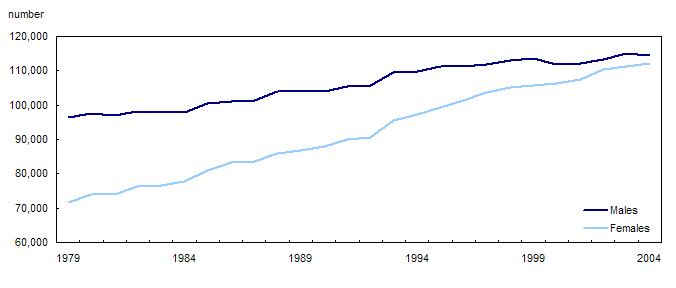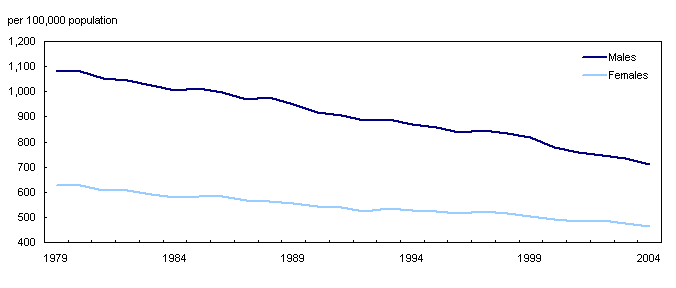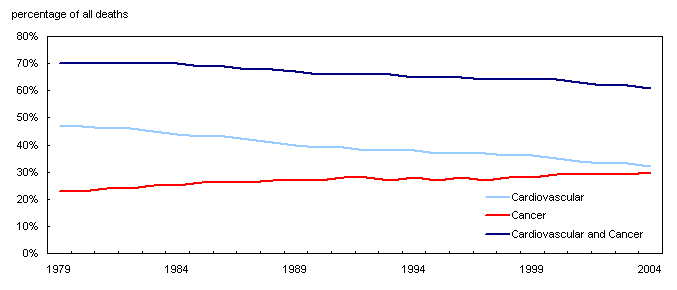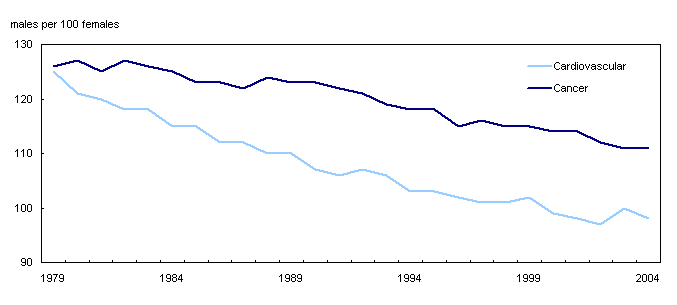Common menu bar links
2004
Archived Content
Information identified as archived is provided for reference, research or recordkeeping purposes. It is not subject to the Government of Canada Web Standards and has not been altered or updated since it was archived. Please "contact us" to request a format other than those available.
Analysis
A. Number of deaths and age-standardized mortality rates, 1979 to 2004
A.1. Annual number of deaths by sex
In 2004, 226,584 deaths were registered in Canada, 415 (or 0.2%) more, than in 2003.
From 1979 to 2004, the annual number of male deaths rose slightly, from 96,532 to 114,513. Since 2000, the number of male deaths appears to be levelling off. During the same 25-year period, the annual number of female deaths rose sharply, from 71,651 in 1979 to 112,071 in 2004.
In 1979, male deaths accounted for 57.4% of all deaths; female deaths accounted for only 42.6%. By 2004, the male share of deaths had fallen to 50.5%, and the female share had risen to 49.5%.

A.2. Age-standardized mortality rates by sex
In 2004, Canada’s age-standardized mortality rate was 572 deaths per 100,000 population, down 2.6% from 587 in 2003.
Males’ age-standardized mortality rate was 710 deaths per 100,000 in 2004, down 3.1% from 2003 and down 34% from 1,083 in 1979.
Females’ age-standardized mortality rate was 466 deaths per 100,000 in 2004, down 1.9% from 2003. It was also a 27% decrease from 1979, when females’ age-standardized mortality rate was 627.
The gap between male and female age-standardized rates decreased by almost half over the period, from 456 deaths per 100,000 in 1979 to 244 in 2004 (Chart 2 ).

B. Trends for two main causes of death by sex, 1979 to 2004
From 1979 to 1999, Statistics Canada used the Ninth Revision of the World Health Organization’s International Classification of Diseases (ICD-9) to classify causes of death. Beginning in 2000 Statistics Canada and the provincial and territorial vital statistics registries implemented a new revision, ICD-10.
The implementation caused some ripples in the data series on causes of death. However, the trends for the two main groups of causes of death discussed in this study were little affected. The comparability ratios were close to 1 (see Comparability of ICD-10 and ICD-9 for Mortality Statistics in Canada, catalogue no. 84-548-XIE, 2005).
Major cardiovascular diseases and malignant neoplasm, the two main groups of causes of death, were selected for this analysis.
For major cardiovascular diseases, hereafter referred to as ‘cardiovascular diseases’, these categories of codes are used:
- ICD-9, codes 320-434, 436-448 (from 1979 to 1999)
- ICD-10, codes I00-I78 (from 2000 to 2004).
For malignant neoplasm, hereafter referred to as ‘cancer’, these categories of codes are used:
- ICD-9, codes 140-208 (from 1979 to 1999)
- ICD-10, codes C00-C97 (from 2000 to 2004).
The analysis is differentiated by sex because cause-of-death trends vary considerably by sex.
B.1. Cardiovascular and cancer deaths
In 2004, cardiovascular and cancer deaths accounted for 61.5% of all deaths. Cardiovascular diseases accounted for 31.9% of deaths and cancer, 29.5%.
Cardiovascular diseases have been the main cause of death in Canada in the last 25 years. However, their share declined to 32% in 2004 from 47% in 1979. The second main cause of death has been cancer, and its share has been growing. Cancer was responsible for 23% of deaths in 1979, and 30% in 2004. With the declining trend of the former and the rising trend of the latter, cancer may soon catch up with — and eventually surpass — cardiovascular diseases as the main cause of death (Chart 3 ).

B.2. Sex ratios of cardiovascular and cancer deaths
From 1979 to 2004, the sex ratio for deaths due to cardiovascular diseases decreased sharply, from 125 to 101 males per 100 females. Thus, in 2004 the number of male and female deaths due to cardiovascular diseases were almost equal — a trend seen since 1997.
From 1979 to 2004, the sex ratio for deaths due to cancer declined gradually, from 126 to 111 males per 100 females.
In 2004, 53% of the people who died due to cancer were males.

C. Cardiovascular and cancer deaths, 2000 to 2004
C.1. Cardiovascular deaths (I00-I78)
From 2000 to 2004, the main cause of death in Canada was cardiovascular diseases.
C.1.1. Annual number of cardiovascular deaths by sex
From 2000 to 2004, a cumulative total of 370,861 died of cardiovascular diseases: 184,282 were males and 186,579 were females (Table 1 ).
During this period, annual deaths due to cardiovascular diseases fell 4.9%, from 76,046 to 72,338 deaths. Male deaths fell by 5.5%, while female deaths fell by 4.3%.
| Year | Cardiovascular diseases | Cancer | ||||
|---|---|---|---|---|---|---|
| Both sexes | Males | Females | Both sexes | Males | Females | |
| number | ||||||
| 2000 | 76,046 | 37,914 | 38,132 | 62,672 | 33,360 | 29,312 |
| 2001 | 74,441 | 36,912 | 37,529 | 63,774 | 34,023 | 29,751 |
| 2002 | 74,209 | 36,605 | 37,604 | 65,103 | 34,415 | 30,688 |
| 2003 | 73,827 | 37,004 | 36,823 | 65,990 | 34,701 | 31,289 |
| 2004 | 72,338 | 35,847 | 36,491 | 66,947 | 35,156 | 31,791 |
| 2000 to 2004 | 370,861 | 184,282 | 186,579 | 324,486 | 171,655 | 152,831 |
C.1.2. Age-standardized mortality rates for cardiovascular diseases by sex
From 2000 to 2004, the age-standardized mortality rate for cardiovascular diseases dropped 16%, from 209 to 176 deaths per 100,000. The rates for each sex also dropped 16%, from 268 to 224 deaths per 100,000 for males and from 164 to 138 deaths per 100,000 for females (Table 2 ).
In 2000, the male age-standardized mortality rate for cardiovascular diseases was 64% higher than the female rate; by 2004, this gap had narrowed slightly to 62%.
| Year | Cardiovascular diseases | Cancer | ||||
|---|---|---|---|---|---|---|
| Both sexes | Males | Females | Both sexes | Males | Females | |
| rate 1 | ||||||
| 2000 | 209.1 | 268.3 | 164.0 | 180.4 | 225.3 | 149.4 |
| 2001 | 197.5 | 252.6 | 155.4 | 178.7 | 223.8 | 147.6 |
| 2002 | 192.1 | 244.9 | 151.9 | 178.2 | 220.5 | 149.3 |
| 2003 | 185.0 | 238.4 | 144.0 | 175.6 | 215.3 | 148.1 |
| 2004 | 175.6 | 223.7 | 137.9 | 173.7 | 212.1 | 147.0 |
C.2. Cancer (C00-C97)
From 2000 to 2004, the second main cause of death for Canadians was cancer.
C.2.1. Annual number of cancer deaths by sex
The cumulative number of cancer deaths from 2000 to 2004 was 324,486: 171,655 were males and 152,831 were females.
Annual deaths due to cancer increased 6.8% in this period, from 62,672 to 66,947. The rise was greater for females, 8.5%, than for males, 5.4%.
From 2000 to 2004, the gap between — or, more precisely, the ratio of — male to female age-standardized mortality rates for cancer narrowed a slight 7%, from 151 to 144 males per 100 females.
C.2.2. Age-standardized mortality rates for cancer by sex
From 2000 to 2004, the age-standardized mortality rate for cancer dropped 3%, from 180 to 174 deaths per 100,000 population. The rate for males fell 8%, from 225 to 212 per 100,000. For females, it slipped just 1%, from 149 to 147 deaths per 100,000.
In 2000, the male age-standardized mortality rate for cancer was 51% higher than the female rate; by 2004, this gap had narrowed to 44%.
C.3. Comparison between cardiovascular and cancer deaths by sex
The cumulative total of annual deaths from 2000 to 2004 due to cardiovascular diseases was 14% lower than the cumulative deaths due to cancer.
Analysis of the two main causes of deaths in Canada shows the following.
- From 1979 to 2004, the number of deaths due to cardiovascular diseases fell sharply, while deaths due to cancer rose. The shares of deaths due to these diseases converged at around 30% in 2004 (Chart 3 ).
- From 2000 to 2004, more females than males died of cardiovascular diseases — 2,297 (or 1%) of excess female deaths (Table 1 ).
- More males than females were killed by cancer from 2000 to 2004 — 18,824 (or 12%) of excess male deaths (Table 1 ).
- From 2000 to 2004, the age-standardized mortality rates for cardiovascular diseases and cancer converged at around 175 deaths per 100,000 population, mainly the result of a sharp drop in the age-standardized mortality rate for cardiovascular diseases (Table 2 ).
- In 2000, both males and females had higher age-standardized mortality rates for cardiovascular diseases than for cancer; however, in 2003 and 2004, female standardized rates for cancer were higher than those for cardiovascular diseases.
- In 2004, male age-standardized mortality rates for cardiovascular diseases were 62% higher than female rates (unchanged from 2000).
- In 2004, male age-standardized mortality rates for cancer were 44% higher than female rates, a decline in the 51% gap posted in 2000.
D. The two main causes of cancer deaths, 2000 to 2004
Cancer of the trachea, bronchus and lung, and cancer of the colon, rectum and anus were the two main groups of cancer deaths in Canada, from 2000 to 2004 (Table 3 ).
During this period, the cumulative five-year annual number of deaths due to these two cancers was 119,475, comprising 37% of all deaths due to cancer. Of these deaths, 68,476 (57%) were males and 50,999 (43%) were females.
D.1. Cancer of trachea, bronchus and lung
Cancer of the trachea, bronchus and lung was the main cause of death due to cancer from 2000 to 2004.
D.1.1. Annual number of deaths by sex
From 2000 to 2004, the cumulative number of deaths due to cancer of the trachea, bronchus and lung was 84,921, comprising 26% of all cancer deaths. Of these deaths, 50,115 (59%) were males and 34,806 (41%) were females (Table 3 ).
During this period, annual deaths due to cancer of the trachea, bronchus and lung increased 9%, from 16,134 to 17,653. Annual number of male deaths due to cancer of the trachea, bronchus and lung rose 5%, from 9,650 to 10,136. Female deaths of this cancer were up 16%, from 6,484 to 7,517 — three times the rate of increase of male deaths.
More men than women died of cancer of the trachea, bronchus and lung during the period. The sex ratio of annual number of deaths due to this cancer decreased from 149 to 135 males per 100 females. This indicates that the gap between the sexes is narrowing for the number of deaths due to this cancer.
D.1.2. Age-standardized mortality rates by sex
From 2000 to 2004, the age-standardized mortality rate for cancer of the trachea, bronchus and lung decreased 1%, from 47.1 to 46.6 deaths per 100,000 population (Table 3 ).
During this period, the male age-standardized mortality rate for cancer of the trachea, bronchus and lung decreased 6%, from 64.3 to 60.6 deaths per 100,000. The female rate increased 5%, from 34.4 to 36.2 per 100,000.
In 2000, male age-standardized mortality rates for cancer of the trachea, bronchus and lung were 87% higher than female rates; by 2004, this gap had narrowed considerably to 67%.
| Causes of deaths | 2000 | 2001 | 2002 | 2003 | 2004 | 2000 to 2004 | |||||
|---|---|---|---|---|---|---|---|---|---|---|---|
| number | rate | number | rate | number | rate | number | rate | number | rate | ||
| Both sexes | |||||||||||
| All cancers | 62,672 | 180.4 | 63,774 | 178.7 | 65,103 | 178.2 | 65,990 | 175.6 | 66,947 | 173.7 | 324,486 |
| Cancer of trachea, bronchus and lung | 16,134 | 47.1 | 16,572 | 47.3 | 17,188 | 47.8 | 17,374 | 47.0 | 17,653 | 46.6 | 84,921 |
| Cancer of colon, rectum and anus | 6,643 | 19.0 | 6,631 | 18.4 | 7,023 | 19.1 | 6,938 | 18.3 | 7,319 | 18.7 | 34,554 |
| Males | |||||||||||
| All cancers | 33,360 | 225.3 | 34,023 | 223.8 | 34,415 | 220.5 | 34,701 | 215.3 | 35,156 | 212.1 | 171,655 |
| Cancer of trachea, bronchus and lung | 9,650 | 64.3 | 9,931 | 64.6 | 10,195 | 64.5 | 10,203 | 62.7 | 10,136 | 60.6 | 50,115 |
| Cancer of colon, rectum and anus | 3,549 | 24.0 | 3,465 | 22.8 | 3,754 | 24.1 | 3,711 | 23.0 | 3,882 | 23.5 | 18,361 |
| Females | |||||||||||
| All cancers | 29,312 | 149.4 | 29,751 | 147.6 | 30,688 | 149.3 | 31,289 | 148.1 | 31,791 | 147.0 | 152,831 |
| Cancer of trachea, bronchus and lung | 6,484 | 34.4 | 6,641 | 34.4 | 6,993 | 35.3 | 7,171 | 35.4 | 7,517 | 36.2 | 34,806 |
| Cancer of colon, rectum and anus | 3,094 | 15.1 | 3,166 | 14.9 | 3,269 | 15.2 | 3,227 | 14.6 | 3,437 | 15.0 | 16,193 |
D.2. Cancer of colon, rectum and anus
Cancer of the colon, rectum and anus was the second main cause of deaths due to cancer from 2000 to 2004.
D.2.1. Annual number of deaths by sex
The cumulative number of deaths over the five-year period due to cancer of colon, rectum and anus was 34,554: 18,361 males and 16,193 females (Table 3 ).
During this period, annual deaths due to cancer of the colon, rectum and anus rose 10%, from 6,643 to 7,319. Annual male deaths increased 9%, from 3,549 to 3,882. Female deaths rose 11%, from 3,094 to 3,437.
From 2000 to 2004, more men than women died due to cancer of the colon, rectum and anus. During this period, the sex ratio of annual number deaths for this cancer remained relatively stable, at around 113 males per 100 females.
D.2.2. Age-standardized mortality rates by sex
From 2000 to 2004, the age-standardized mortality rate for cancer of the colon, rectum and anus decreased slightly, from 19.0 to 18.7 deaths per 100,000 population (Table 3 ).
During this period, the male age-standardized mortality rate for cancer of the colon, rectum and anus fell 2%, from 24.0 to 23.5 deaths per 100,000, while female rates hovered around 15.0 deaths per 100,000.
E. Selected cancer deaths by sex, 2000 to 2004
E.1. Selected male cancer deaths
The three main cancers responsible for male deaths were cancer of the trachea, bronchus and lung; cancer of the colon, rectum and anus; and cancer of the prostate.
E.1.1. Annual number of male deaths due to cancer
From 2000 to 2004, these three groups of cancer killed 87,070 males in Canada — 50.7% of all male deaths due to cancer (Table 4 ).
The shares of each category of cancer deaths during this period were:
- cancer of the trachea, bronchus and lung accounted for 29.2% of all male cancer deaths;
- cancer of the colon, rectum and anus accounted for 10.7% of all male cancer deaths;
- cancer of the prostate accounted for 10.8% of all male cancer deaths.
From 2000 to 2004, the annual number of deaths due to prostate cancer remained relatively stable at approximately 3,700.
E.1.2. Age-standardized mortality rates for males
The age-standardized mortality rate for male prostate cancer decreased from 2000 to 2004 from 26.7 to 23.4 deaths per 100,000 population (Table 4 ).
| Causes of deaths | 2000 | 2001 | 2002 | 2003 | 2004 | 2000 to 2004 | |||||
|---|---|---|---|---|---|---|---|---|---|---|---|
| number | rate | number | rate | number | rate | number | rate | number | rate | ||
| Males | |||||||||||
| All cancers | 33,360 | 225.3 | 34,023 | 223.8 | 34,415 | 220.5 | 34,701 | 215.3 | 35,156 | 212.1 | 171,655 |
| Cancer of trachea, bronchus and lung | 9,650 | 64.3 | 9,931 | 64.6 | 10,195 | 64.5 | 10,203 | 62.7 | 10,136 | 60.6 | 50,115 |
| Cancer of colon, rectum and anus | 3,549 | 24.0 | 3,465 | 22.8 | 3,754 | 24.1 | 3,711 | 23.0 | 3,882 | 23.5 | 18,361 |
| Cancer of prostate | 3,718 | 26.7 | 3,825 | 26.6 | 3,708 | 25.2 | 3,658 | 24.1 | 3,685 | 23.4 | 18,594 |
| Females | |||||||||||
| All cancers | 29,312 | 149.4 | 29,751 | 147.6 | 30,688 | 149.3 | 31,289 | 148.1 | 31,791 | 147.0 | 152,831 |
| Cancer of trachea, bronchus and lung | 6,484 | 34.4 | 6,641 | 34.4 | 6,993 | 35.3 | 7,171 | 35.4 | 7,517 | 36.2 | 34,806 |
| Cancer of colon, rectum and anus | 4,857 | 25.0 | 4,968 | 24.9 | 4,977 | 24.4 | 5,060 | 24.1 | 4,964 | 23.1 | 24,826 |
| Cancer of prostate | 3,094 | 15.1 | 3,166 | 14.9 | 3,269 | 15.2 | 3,227 | 14.6 | 3,437 | 15.0 | 16,193 |
E.2. Selected female cancer deaths
The three main cancers responsible for female deaths were cancer of the trachea, bronchus and lung; cancer of the breast; and cancer of the colon, rectum and anus.
E.2.1. Annual number of female deaths due to cancer
From 2000 to 2004, the three main categories of cancers killed 75,825 females in Canada — 49.6% of all female deaths due to cancer (Table 4 ).
The share of each category of cancer deaths during this period were:
- cancer of the trachea, bronchus and lung caused 22.8% of all female cancer deaths;
- breast cancer caused 16.2% of all female cancer deaths;
- cancer of the colon, rectum and anus caused 10.6% of all female cancer deaths.
The annual number of deaths from 2000 to 2004 due to breast cancer increased a slight 2%, from 4,857 to 4,964.
E.2.2. Age-standardized mortality rates for females
The age-standardized mortality rate for female breast cancer fell 8%, from 25.0 deaths per 100,000 population in 2000 to 23.1 in 2004 (Table 4 ).
E.3. Comparison of male versus female deaths due to selected cancers
The following are the main differences in the number of male and female deaths due to selected cancers:
- The relative share of all three main categories combined of male cancer deaths, 50.9%, was similar to the relative share of all three main categories combined of female cancer deaths, 49.6%. However, the relative share of each individual category of cancer varied between the sexes.
- Male deaths due to cancer were concentrated in cancer of the trachea, bronchus and lung.
- Female deaths due to cancer were more evenly distributed among cancer of the trachea, bronchus and lung, and breast cancer.
- Recent trends indicate that female deaths due to cancer of the trachea, bronchus and lung, are getting closer to the level of male deaths.
- Deaths due to male-specific prostate cancer and female-specific breast cancer were relatively stable from 2000 to 2004.
- The narrowing of the gap between the number of overall male deaths and overall female deaths seen in Chart 1 may be partly explained by the narrowing of the gap between the number of deaths for each sex due to the two main causes of death: cardiovascular diseases and cancer (Charts 2 , 3 and 4 ).
The following are the main differences in the male and female age-standardized mortality rates for selected cancers:
- Recent trends in age-standardized mortality rates for cancer of the trachea, bronchus and lung show a rising trend among females and a descending trend among males.
- Age-standardized mortality rates for male prostate cancer and female breast cancer decreased in recent years. However, the drop was sharper for the male prostate cancer rate than for female breast cancer.


